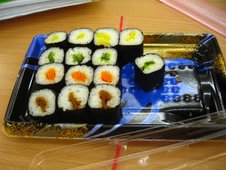Vegan Pitfalls in Japan
Before coming to Japan, I thought that being a vegetarian here would be relatively easy. Afterall, there is a high Buddhist population and everyone always goes on about how the Japanese never traditionally ate meat or milk. I couldn't have been more wrong! Almost everything produced or consumed in this country contained fish or fish products. Even among Buddhists, "vegetarians" are expected to eat fish and most practicing Buddhists in Japan aren't vegetarians (even in this limited sense) at all.
The other day I was looking into ryokan (traditional Japanese hotel) accomodation which usually includes dinner and breakfast. I was delighted to find vegetarian meal options, until I read the fine print "Vegetarian (fish)" or "Vegetarian (no fish but with fish broth)." This illustrates the extent of vegetarian options in the country at large as well.
For tips on what to eat (and yes, there are some options) see my "Introduction to Japanese Food," this post will be some warnings of surprising non-vegan products and pitfalls. The moral of the story is: READ LABELS and ASK QUESTIONS! or stick to raw fruits and veggies.
Potato Chips: Often contains katsuo or fish seasoning and if they don't, they may contain chicken (even Pringles or other western brands are not safe).
Sembe (rice crackers): I'd say there's about a 50/50 chance that even ones called "salad," "vegetable," or "plain" flavour will contain katsuo or other fish seasonings.
Dashi (soup stock): Make your own or go without. All soup in Japan contains fish.
Salad Dressing: Again, almost always contains katsuo or eggs. I've had the best luck with sesame ones but I usually just use some balsamic vinegar with salt and pepper.
Kimchee: Very popular in Japan. I'm not sure what traditional Korean kimchee might contain but I have never seen any in Japan without fish products.
Cup noodles, instant curry, TV dinners: Except for some boxed curries that are imported (and come in English boxes), I have never seen one that's vegan.
Tsukemono (pickled vegetables): Often contains katsuo.
Gum: Although Western gum is almost always safe, Japanese gum almost always contains gelatin!
Candy: Hard candy is fine (of course) but gummies here always contain gelatin (not pectin).
Soy milk: Usually includes cow's milk as well. I have no idea why, but of course these products are not being made with vegetarians (or vegans) in mind. They also don't usually have added calcium. There are a few with nothing but soybeans and water--usually the cheaper ones too, although not so tasty. Western syle soy milks are available at health food or foreign import stores.
Bread: Sold in tiny loaves and almost always contains milk products. Check the bakeries for vegan bread--they usually have convenient little signs that mark a circle or an x by the kanji for milk, eggs, wheat, soy, etc. (circles mean contains).



